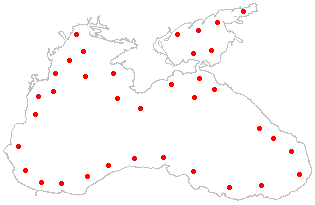
Acipenser stellatus (Pallas, 1711)

Synonyms: Acipenser helops Pallas, 1811; Acipenser stellatus donensis Lovetzky, 1834; Acipenser stellatus ilyricus Brusina, 1902; Acipenser stellatus stellatus Banarascu, 1964.
Common names: Engl: Starry sturgeon; Bulg: Pestruga; Rom: Pastruga; Russ: Sevryuga; Turk: Mersin javrusu; Ukr: Sevryuga.
Order (Scientific): ACIPENSERIFORMES.
Family (Scientific): ACIPENSERIDAE.
Taxonomic descriptions: Body subcylindical and very elongate, with bony scutes arranged in 5 rows, one on the middle of the back, one pair on the sides and another on the belly; on the isthmus, beneath the head, a pair of triangular-shaped bony scutes. the mouth, placed beneath the head is small, transverse and can be projected as a short tube; lower lip interrupts at the mid-line; snout swordlike and very long, making up more than 60% of the head length; barbels on the underside of the snout short, ending well before the mouth and inserted nearer to the mouth than to the tip of the snout; back and sides coffee-brown, belly whitish. Size: Maximum - 180 cm; common - 130 to 140 cm (females) and 110 to 120 cm (males).
 IUCN
Status:
IUCN
Status:
World level:
Black Sea Regional level:
Subregion level: VU
Distribution:
Habitats type, Critical habitats, Limiting factors: Inhabits waters close to the bottom, in the summer in coastal zones, coming up to the surface for feeding at night; enters the Kuban, Don, Dniepr, Danube and other rivers flowing into the Black Sea, also in Sinoe lagoon. Abundant in the Azov and Caspian Sea, rare in the Marmara; only incidentally recorded for the Mediterranean (Adriatic).
Biology: A migratory anadromous species enters the rivers in April-October. Reproduction in May-June; a female can lay dawn 20,000-360,000 eggs. Sexual maturity - 5 years old (male) and 7 (female). Feeds mainly on fishes, also molluscs, crustaceans and chironomds. Caught mainly with stake nets, drift nets and beach seines. A highly esteemed fish. It is a ponto-caspian relict.
Population trends: Like Acipenser güldenstaedti, this species has diminished in population in 1940-1960 (80%), compared with the previous two decades (1920-1940). In the catches of the northern zone of the Romanian littoral (Chituc - Vadu), in May 1991 this species represented 50 kg (15 specimens); in June 30 kg (11 specimens) and in August 14 kg (358 specimens, all juveniles). The catches recorded for the entire Romanian littoral were: 1989 - 19,000 t; 1990 - 4,000 t, 1991 - 15,000 t, for Bulgaria 15,000 t (1989), for US 27,000 t (1989), 15,000 (1990), 15,000 (1991). For the 1993-1994, the exploitable stock was assessed at 220,000 specimens, for the North-Western area of the Black Sea.
Threats: Overfishing, large hydraulics projects which blocked traditional routes for migration and access to spawning areas.
Conservation measures taken: This species is under the protection in Turkey since 1997. Total catch was 110 tons in 1995. A special recovery and monitoring programme was started by the Turkish Marine Research Foundation in Sakarya and Kizilirmak estuaries.
Conservation measures proposed: Protection of spawners during migration and spawning time; protection of spawning and feeding area; artificial reproduction; adopt strict national measures to reduce poaching.
References:
Compiled by: A.Petranu, B.Öztürk.